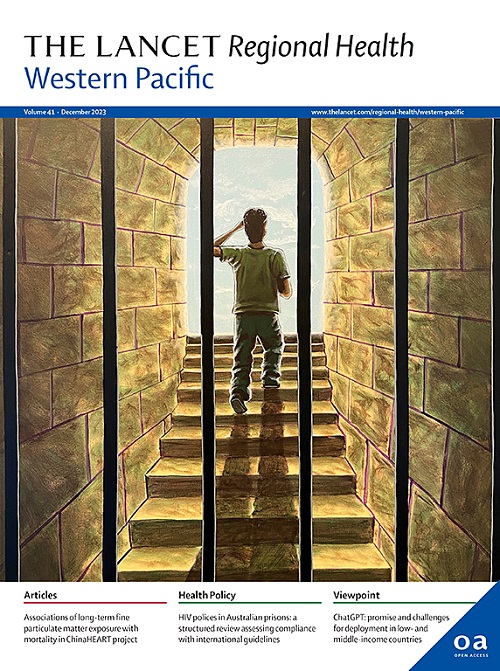Longitudinal trajectories of triglyceride glucose index and colorectal cancer mortality in Chinese older adults: a large prospective cohort study
IF 7.6
1区 医学
Q1 HEALTH CARE SCIENCES & SERVICES
引用次数: 0
Abstract
Background
Colorectal cancer (CRC) is the second leading cause of cancer-related deaths worldwide in 2022. Triglyceride glucose (TyG) index, as a more convenient and reliable predictor of insulin resistance, is associated with cardiometabolic diseases, but its relationship with CRC remains unclear. Although evidence from previous prospective cohort studies indicated that people with higher baseline TyG index were associated with onset of CRC, most of these studies have focused on elevated baseline TyG index levels rather than its dynamic changes over time. This study aimed to evaluate the long-term trajectories of the TyG index and the mortality due to CRC.
Methods
We used data from a Multi-center Elderly Health Management Cohort Study in Luzhou and Zunyi, China. Participants aged ≥65 years were enrolled from January 2017 and followed up until December 2021. Baseline data came from annual health examinations from the health management programs for the elderly in basic public health services including standardized questionnaires and laboratory tests. Demographic information, lifestyles, and health conditions were collected. TyG index was calculated by fasting blood glucose and triglycerides. Deaths from all-cause and CRC were obtained from linkage with China's national death registration system. CRC death as underlying cause of death was defined as International Classification of Diseases, 10th revision codes C18-C20. The latent class trajectory modeling method was used to analyze the 5-year TyG index trajectories from registration and the Cox proportional hazards regression model was utilized to examine the relationship between baseline TyG index level, the trajectory of TyG index, and CRC mortality.
Findings
Among 767,483 older adults, 52.9% were females; the mean age at baseline was 70.4 years. A total of 39,738 deaths (including 700 from CRC) were recorded in a median follow-up of 3.8 years [IQR 2.4-5.2]). Three longitudinal patterns based on the 5-year TyG index were identified: “medium-stable trajectory” (n=374,345, 48.8%), “low-stable trajectory” (n=334,645, 43.6%), and “high-stable trajectory” (n=58,493, 7.6%). Compared with the lowest quartile TyG index in the baseline, there was a borderline significant higher risk of CRC mortality for the highest quartile (hazard ratio 1.23, 95% confidence interval 0.98-1.54, p=0.07) after adjustment for age, sex, years of schooling, alcohol consumption, smoking, exercise frequency, diabetes, hypertension, cardiovascular and cerebrovascular diseases. Compared with medium-stable TyG index pattern, individuals with a high-stable TyG index had lower CRC mortality, with a crude hazard ratio (95% CI) of 0.71 (0.50-0.99). In the fully adjusted model, neither low-stable trajectory group nor high-stable trajectory group showed any significant association with CRC mortality (low-stable trajectory hazard ratio: 0.96 (95% CI: 0.82-1.13); high-stable trajectory hazard ratio: 0.78 (95% CI: 0.55-1.11)).
Interpretation
Although a borderline significant association was found between highest quartile TyG index at baseline and CRC mortality, there was no significant association with CRC mortality for trajectory pattern of TyG index. Such finding might be due to the slightly shorter follow-up period but to some extent, it also suggests that strict adherence to normal values for metabolic indicators may not be necessary in older Chinese adults, although more prospective evidence with longer follow-up is still needed.
中国老年人甘油三酯葡萄糖指数与结直肠癌死亡率的纵向轨迹:一项大型前瞻性队列研究
到2022年,结直肠癌(CRC)是全球癌症相关死亡的第二大原因。甘油三酯葡萄糖(TyG)指数作为一种更方便、更可靠的胰岛素抵抗预测指标,与心脏代谢疾病相关,但与结直肠癌的关系尚不清楚。尽管先前前瞻性队列研究的证据表明,基线TyG指数较高的人与CRC的发病有关,但这些研究大多侧重于基线TyG指数水平的升高,而不是其随时间的动态变化。本研究旨在评估TyG指数和结直肠癌死亡率的长期轨迹。方法采用中国泸州和遵义多中心老年人健康管理队列研究数据。年龄≥65岁的参与者从2017年1月开始入组,随访至2021年12月。基线数据来自基本公共卫生服务老年人健康管理项目的年度健康检查,包括标准化问卷调查和实验室检查。收集了人口统计信息、生活方式和健康状况。通过空腹血糖和甘油三酯计算TyG指数。全因死亡和结直肠癌死亡是通过与中国国家死亡登记系统的联系获得的。作为潜在死因的结直肠癌死亡被定义为《国际疾病分类》第十次修订代码C18-C20。采用潜类轨迹建模方法分析登记后的5年TyG指数轨迹,采用Cox比例风险回归模型检验基线TyG指数水平、TyG指数轨迹与结直肠癌死亡率之间的关系。767483名老年人中,女性占52.9%;基线时平均年龄为70.4岁。在中位3.8年的随访中,共记录了39,738例死亡(包括700例结直肠癌)[IQR 2.4-5.2]。基于5年TyG指数,确定了3种纵向模式:“中稳定轨迹”(n=374,345, 48.8%)、“低稳定轨迹”(n=334,645, 43.6%)和“高稳定轨迹”(n=58,493, 7.6%)。与基线时TyG指数最低的四分位数相比,调整年龄、性别、受教育年限、饮酒、吸烟、运动频率、糖尿病、高血压、心脑血管疾病等因素后,最高四分位数的CRC死亡风险显著增高(风险比1.23,95%可信区间0.98-1.54,p=0.07)。与中稳定的TyG指数模式相比,高稳定的TyG指数个体CRC死亡率较低,粗风险比(95% CI)为0.71(0.50-0.99)。在完全调整模型中,低稳定轨迹组和高稳定轨迹组均未显示出与CRC死亡率的显著相关性(低稳定轨迹风险比:0.96 (95% CI: 0.82-1.13);高稳定轨迹风险比:0.78 (95% CI: 0.55-1.11)。虽然发现基线时最高四分位数TyG指数与CRC死亡率之间存在显著的相关性,但TyG指数的轨迹模式与CRC死亡率没有显著相关性。这一发现可能与随访时间稍短有关,但在一定程度上也表明,中国老年人可能没有必要严格遵守代谢指标正常值,尽管仍需要更多的前瞻性证据和更长的随访时间。
本文章由计算机程序翻译,如有差异,请以英文原文为准。
求助全文
约1分钟内获得全文
求助全文
来源期刊

The Lancet Regional Health: Western Pacific
Medicine-Pediatrics, Perinatology and Child Health
CiteScore
8.80
自引率
2.80%
发文量
305
审稿时长
11 weeks
期刊介绍:
The Lancet Regional Health – Western Pacific, a gold open access journal, is an integral part of The Lancet's global initiative advocating for healthcare quality and access worldwide. It aims to advance clinical practice and health policy in the Western Pacific region, contributing to enhanced health outcomes. The journal publishes high-quality original research shedding light on clinical practice and health policy in the region. It also includes reviews, commentaries, and opinion pieces covering diverse regional health topics, such as infectious diseases, non-communicable diseases, child and adolescent health, maternal and reproductive health, aging health, mental health, the health workforce and systems, and health policy.
 求助内容:
求助内容: 应助结果提醒方式:
应助结果提醒方式:


